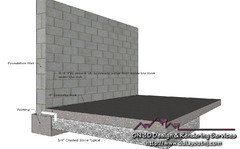Need help for how to repair basement leak in cinder block wall
We own a newly-constructed (in 2015-16) house that was built with one wall that was used from a previous house's foundation. The old foundation wall, cinder block, is about 50-60 years old. About 8 months into our living in the house, the wall began leaking. There are 3-4 pinhole sized leaks 1/3 of the way up the wall, and some seepage along the seam where the wall meets the floor. It's not leaking excessively, and mostly when there is extreme rainfall (mainly occurred back in the spring soon after a great deal of snow melted).
We are working with the builder on getting this problem fixed. Since the house was built on a partly pre-existing foundation, we have only 1 year of workmanship warranty on the house.
We have the following options:
1. (builder's preferred option): drill holes in the cinderblock and fill the walls with concrete, just above where the pin hole leaks were occurring.
2. install a drain system around the perimeter of the cinderblock basement area and lead this to sump pump
3. install a track system epoxy'ed to the floor (I've seen them referred to as a 'beaver system') lead this to sump pump.
We've been able to find a lot of information on option #2, which seems to be a preferred or more typical method, but not so much on options #1 and #3. Builder proposed and is willing to do option 1, and says he's willing to pay for a part of option 3. We want a long term solution, but understand that the leak is fairly small at present. Water seems to be diverting away from the house properly otherwise; gutters and downspouts are all working very well as reported from a few contractors and our gutter cleaners.
Has anyone had a good or bad experience with the injecting cinder block with cement option or beaver track system?
Comments (8)
schreibdave
6 years agoI would have thought that the perimeter foundation drain would have been done when the rest of tbe foundation was built. Good luck.
NJ Gardener thanked schreibdaveNJ Gardener
Original Author6 years agoThanks. Yes, I mean filling the cinderblock with grout. We're still not sure which way to go... we're told that there was a new perimeter drain installed on the outside of the old/original foundation wall, but they didn't do one for the interior of the wall (they didn't want to break up the floor).
GN Builders L.L.C
6 years agolast modified: 6 years agoBest way to deal with something like this, if to allow the water to bypass the block and drain out under the slab. The water will percolate into the ground below the slab or find its way into the sump pump. We do this all the time and this method is approved by most engineers.
The way this is done, on the problematic wall, you cut a narrow strip of the slab near the block wall 4' on center (strip to cut 3" x 8" big enough to install the pipe), drill a hole in the block and install a 3/4 PVC pipe with a 90-degree elbow and fill the cut portion of concrete with cement. If you handy enough it can be done DIY with a few tools you can rent for 1/2 day rental, if not you can hire a local masonry contractor and they can do that in one day. Here is a cross section so you get an idea.

Filling with cement is not a good idea, you will not fill cinder block cells solid enough to prevent water seepage it will be a waste of time, money and too much work. If you have a cracked concrete wall the repair can be done by installing injector ports and the crack can be filled solid using epoxy.
worthy
6 years agoCurious how one would know just what blocks to drill?
Every time we've had to cure a leaky wall from no obvious source, we excavated from the outside, replaced footer drains and waterproofed. In the old days, it was layers of bitumen-saturated fibre glass followed by fibreglass drainage/insulating mats. Later, we used plastic waterproofing membrane.
GN Builders L.L.C
6 years agoI remember the good old days you talking about, we use to install steel I-beams when we had bowed foundation walls...today we install carbon-fiber straps 1/8" thick encapsulated in epoxy and they 10 times stronger than steel and do much better job. :-)
Design Inside - Chicago
6 years agoWe have seen solutions that use epoxy to fill the holes.
If you have a large portion of the wall exposed and are planning on finishing off the space, installing an interior drain tile system may be the most cost-effective route.
The best solution though is to fix the issue from the outside. Unfortunately, this is probably the most expensive route and will cause you to dig up around your foundation and may require the removal of any landscaping, porches, decks, etc.
In my own home from the 1930s with a cinder block foundation, I chose the interior drain tile solution. It's been dry for 4 years and we have now finished off the space with drywall and flooring.
Here is a good article from US Waterproofing, a local Chicago waterproofing company. We used them for our house and they have great blog posts explaining the common basement seepage issues: http://www.uswaterproofing.com/learning-center/basement-crack-repair-6-things-you-need-to-know
NJ Gardener thanked Design Inside - Chicago
worthy